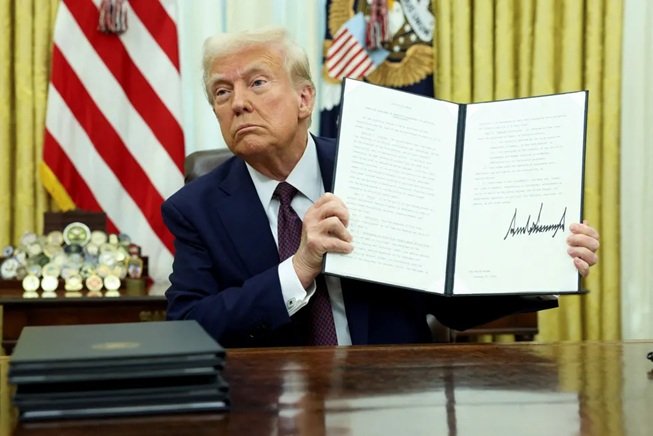-
VRIGHT Exchange | Research & Strategy Desk posted an update in the group Visionary Market Voices
1 month, 1 week agoH-1B Visa Fee Hike: What It Means for India, Companies, and Professionals
By VRIGHT Exchange Research and Strategy Desk
The U.S. government’s recent proposal to impose a $100,000 fee on new H-1B visa petitions marks a major shift in immigration policy with the potential to reshape global talent flows.
Signed by President Donald Trump, the proclamation aims to overhaul the H-1B visa program to curb perceived overuse. With Indian professionals accounting for nearly 70% of all H-1B visa holders, roughly 140,000 Indians annually—out of ~280,000 approvals—could be directly impacted.
This unprecedented fee hike is expected to have significant implications for India’s IT sector, broader economy, and the career prospects of thousands of highly skilled professionals.
The Strategic Intent Behind the Fee Increase
The substantial fee increase reflects a calculated policy shift driven by multiple converging factors. The Trump administration aims to reduce America’s reliance on foreign skilled workers while prioritizing opportunities for domestic talent.
This protectionist approach serves dual purposes: generating substantial revenue for immigration enforcement and workforce development programs while creating a natural filter that ensures only companies with genuinely critical hiring needs will participate in the H-1B program.
The policy, which went into effect as of September 21, 2025, initially created confusion when Commerce Secretary Howard Lutnick had said Friday that companies would have to pay $100,000 per year for H-1B worker visas.
But White House spokesperson Karoline Leavitt said Saturday on X that it was not an annual fee, only a one-time fee that applied to each petition.
The administration has clarified that the $100,000 is a one-time fee that only applies to new visas and is not an annual payment. It does not apply to renewals or current visa holders.
Transforming India’s IT Landscape
The fee increase will fundamentally alter the operating dynamics of India’s $245 billion IT industry. Major players including Infosys, Tata Consultancy Services, Wipro, HCL Technologies, and Tech Mahindra—historically among the largest H-1B sponsors—now face an additional cost burden of approximately ₹90 lakh per candidate. This represents a 10-fold increase from previous fee structures, severely impacting project economics and profit margins.The immediate response will likely involve accelerated offshore migration of work back to India or to alternative nearshore destinations including Mexico, Poland, and the Philippines.
While this shift could generate employment opportunities within India’s domestic market, it simultaneously reduces the Indian IT sector’s physical presence in the lucrative U.S. market, potentially limiting relationship-building and business development capabilities.
Moreover, this change creates a competitive disadvantage relative to IT services firms from Eastern Europe, Latin America, and other regions that have historically relied less heavily on H-1B visa sponsorships.Indian companies must now rapidly pivot toward higher-value service offerings, accelerate automation initiatives, and enhance their artificial intelligence and digital transformation capabilities to maintain competitive positioning.
Impact on Professional Careers and Migration Patterns
For individual Indian professionals, the new fee structure creates a dramatically more selective environment. Employers will become significantly more discriminating, likely limiting sponsorships to specialized roles in cutting-edge fields such as artificial intelligence, semiconductor design, advanced fintech applications, and breakthrough healthcare research.
Mid-level and entry-level positions that previously offered H-1B pathways will become increasingly inaccessible.
Indian students completing degrees in the United States face particularly challenging prospects. Those on Optional Practical Training (OPT) status will find fewer employers willing to invest $100,000 in visa sponsorship, effectively narrowing their post-graduation career options and potentially forcing many to return to India despite their American educational investments.
This shift will likely accelerate migration toward alternative destinations. Canada’s Express Entry system, Australia’s skilled migration programs, and various European Union pathways may experience increased applications from Indian professionals previously focused on U.S. opportunities. Countries with more welcoming immigration policies could benefit significantly from this talent redirection.
Economic Ramifications for India
The economic implications extend far beyond the IT sector. Reduced migration to the United States could negatively impact India’s remittance inflows, which totaled approximately $111 billion in 2022 (Highest inflows to date). Fewer Indians working in high-paying U.S. technology roles means diminished foreign currency earnings for Indian families and communities.
However, this challenge simultaneously presents opportunities for domestic economic development. The retention of skilled professionals who might otherwise have migrated could energize India’s startup ecosystem, strengthen emerging technology hubs in cities like Bengaluru, Hyderabad, and Pune, and accelerate the growth of Global Capability Centers (GCCs) established by multinational corporations seeking to access Indian talent without visa complications.
The Indian government may need to respond with enhanced domestic opportunity creation, particularly in artificial intelligence, financial technology, and deep tech sectors, to ensure that retained talent contributes productively to national economic development rather than experiencing underemployment or brain waste.
Strategic Business and Investment Implications
From an investment perspective, the fee increase presents a complex picture with varying timeframes for impact assessment. Short-term effects will likely include margin pressure on Indian IT firms and potentially slower revenue growth from U.S. operations as companies adjust their business models and pricing strategies.
Medium-term adaptation strategies will involve increased offshore delivery capabilities, geographic market diversification, and enhanced automation to offset reduced on-site presence. Companies that successfully navigate this transition may emerge stronger and more resilient.
Long-term opportunities could prove substantial if India effectively captures and channels the retained talent toward domestic innovation and entrepreneurship. The expansion of GCCs, growth in domestic technology adoption, and strengthening of India’s position as a global innovation hub could ultimately compensate for reduced U.S. market access.
Conclusion: A New Chapter in Global Talent Mobility
The H-1B fee increase represents more than a policy adjustment—it signals a fundamental reconfiguration of global talent mobility patterns. For India, this change demands strategic recalibration across multiple dimensions: corporate business models, individual career planning, and national economic development strategies.
While the immediate challenges are significant, India’s response to this shift will ultimately determine whether it emerges as a victim of changing immigration policies or as a beneficiary of enhanced domestic talent retention and innovation ecosystem development.
The coming years will reveal whether Indian companies and professionals can successfully adapt to a world where the United States is no longer the default destination for skilled migration, potentially unlocking new sources of economic growth and technological advancement within India itself.


